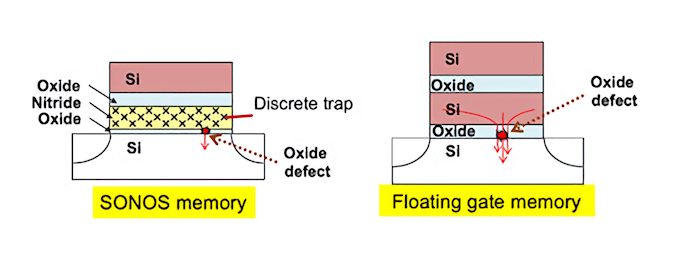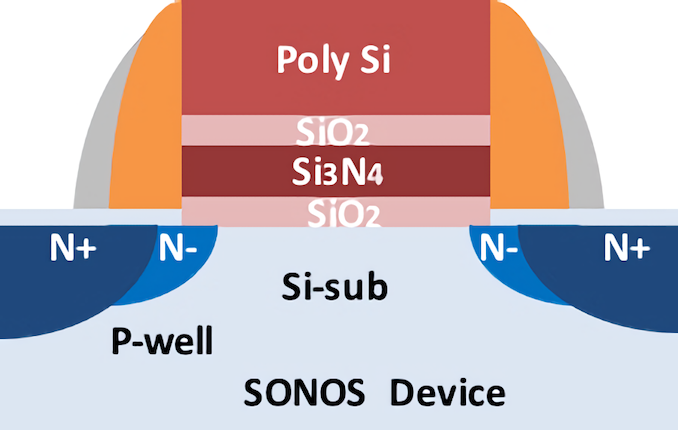Startup Showcases 7 bits-per-cell Flash Storage with 10 Year Retention
by Dr. Ian Cutress on December 15, 2021 11:30 AM EST
One of the key drivers to increase capacity in next generation storage has been to increase the number of bits that can be stored per cell. The easy jump of one to two bits-per-cell gives a straight 100% increase, in exchange for more control needed to read/write the bit but also limits the cell endurance. We’ve seen commercialization of storage up to four bits-per-cell, and talk about five. A Japanese company is now ready to start talking about their new 7 bits-per-cell solution.

Image courtesy of Plextor, up to 4 bits-per-cell
Moving from one to two bits-per-cell gives an easy doubling of capacity, and moving to three bits-per-cell is only another 50% increase. As more bits are added, the value of adding those bits diminishes, but the cost in the equipment to control the read and writes increases exponentially. There has to be a medium balance between how many bits-per-cell makes economic sense, and how much the control electronics costs to implement to enable those bits.
- 1 bit per cell requires detection of 2 voltage levels, base capacity
- 2 bit per cell requires detection of 4 voltage levels, +100% capacity
- 3 bit per cell requires detection of 8 voltage levels, + 50% capacity
- 4 bit per cell requires detection of 16 voltage levels, +33% capacity
- 5 bit per cell requires detection of 32 voltage levels, +25% capacity
- 6 bit per cell requires detection of 64 voltage levels, +20% capacity
- 7 bit per cell requires detection of 128 voltage levels, +16.7% capacity
Also, the more bits-per-cell, the lower the endurance – the voltage variation when you store many bits only has to drift slightly to get the wrong result, and so repeated read/writes to a high capacity cell will make that voltage drift until the cell is unusable. Right now the market seems happy with three bits-per-cell (3bpc) for performance and four bits-per-cell (4bpc) for capacity, with a few 2bpc designs for longer term endurance. Some of the major vendors have been working on 5bpc storage, although the low endurance may make the technology only good for WORM – write once, read many, which is a common acronym for the equivalent of something like an old-school CD or non-rewritable DVD.
Floadia Corp., a Series C startup from Japan, issued a press release this week to state that it has developed storage technology capable of seven bits-per-cell (7bpc). Still in the prototype stage, this 7bpc flash chip, likely in a WORM scenario, has an effective 10-year retention time for the data at 150C. The company says that a standard modern memory cell with this level of control would only be able to retail the data for around 100 seconds, and so the secret in the design is to do with a new type of flash cell they have developed.
The SONOS cell uses a distributed charge trap design relying on a Silicon-Oxide-Nitride-Oxide-Silicon layout, and the company points to an effective silicon nitride film in the middle where the charges are trapped to allow for high retention. In simple voltage program and erase cycles, the company showcases 100k+ cycles with a very low voltage drift. The oxide-nitride-oxide layers rely on SiO2 and Si3N4, the latter of which is claimed to be easy to manufacture. This allows a non-volatile SONOS cell to be used in NV-SRAM or embedded designs, such as microcontrollers.
It’s actually that last point which means we’re a long time from seeing this in modern NAND flash. Floadia is currently partnering with companies like Toshiba to implement the SONOS cell in a variety of microcontrollers, rather than large NAND flash deployments, at the 40nm process node as embedded flash IP with compute-in-memory properties. Those aren’t at 7 bits-per-cell yet, to the effect that the company is promoting that two cells can store up to 8-bits of network weights for machine learning inference – when we get to 8 bits-per-cell, then it might be more applicable. The 10-year retention of the cell data is where it gets interesting, as embedded platforms will use algorithms with fixed weights over the lifetime of the product, except for the rare update perhaps. Even with increased longevity, Floadia doesn’t go into detail regarding cyclability at 7bpc at this time.
An increase from modern 3bpc to 6bpc NAND flash would afford a double density increase, however larger cells would be needed, which would negate the benefits. There’s also the performance aspect if the development of >4bpc ever made it to consumers, which hasn’t been touched upon.
It will be an interesting technology to follow.
Source: Floadia Press Release












48 Comments
View All Comments
vlad42 - Wednesday, December 15, 2021 - link
7-bits per cell, great...I guess this means that soon our SSDs' write performance will barely match that of the old 3.5" floppy drives while only allowing 5 power-erase cycles before dying.
Drkrieger01 - Wednesday, December 15, 2021 - link
Wow... someone didn't even read the article, just commented on the title.Wrs - Thursday, December 16, 2021 - link
It's getting used as PROM, like a BIOS chip, not like disk storage.vlad42 - Thursday, December 16, 2021 - link
That might be how it is used initially, but can we really trust manufacturers to not use it for normal SSDs? They could certainly claim high capacity to the uninformed masses. They're already pushing some questionable QLC based drives into the market. I remember Anandtech reviewing one that had HDD write levels of performance.Samus - Saturday, December 18, 2021 - link
Trust manufacturers? Let the market decide what products fail.Alexvrb - Sunday, January 2, 2022 - link
We've worked so hard in secret... the time has finally come... to resurrect the Maxtor brand.mode_13h - Monday, January 3, 2022 - link
LOL. Maxtor HDDs actually used to be good, once upon a time.vlad42 - Thursday, December 16, 2021 - link
I did read the article, congrats on being an asshole.We have seen the trend for years now. Every time they increase the number of bits-per cell, it is only a matter of time before that that tech is used in all consumer SSDs. We have seen this with SLC, MLC, TLC and we are starting the process of transitioning to QLC. I remember when it was claimed that QLC would only be used for write once read multiple times scenarios. That sure did not last, so why would you think otherwise here?
mode_13h - Saturday, December 18, 2021 - link
> That sure did not last, so why would you think otherwise here?Because, when you get down into the details, they're talking about effectively 4-bits per cell on 40 nm technology.
I think the 7 bpc was a stunt meant to grab headlines, because the node it used was never specified. Either that, or they actually *did* say what node it was, and the article is at fault for failing to report it. I wouldn't be surprised if it was something truly archaic, of the sort that's cheap enough for small-batch university research projects.
yetanotherhuman - Monday, December 20, 2021 - link
The last SSD I bought was MLC, which is hard to find these days, and very expensive. I see TLC as game-drive quality at best, QLC is just e-waste.